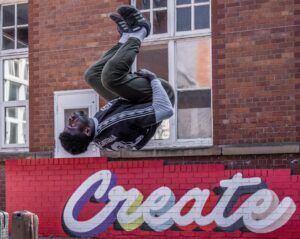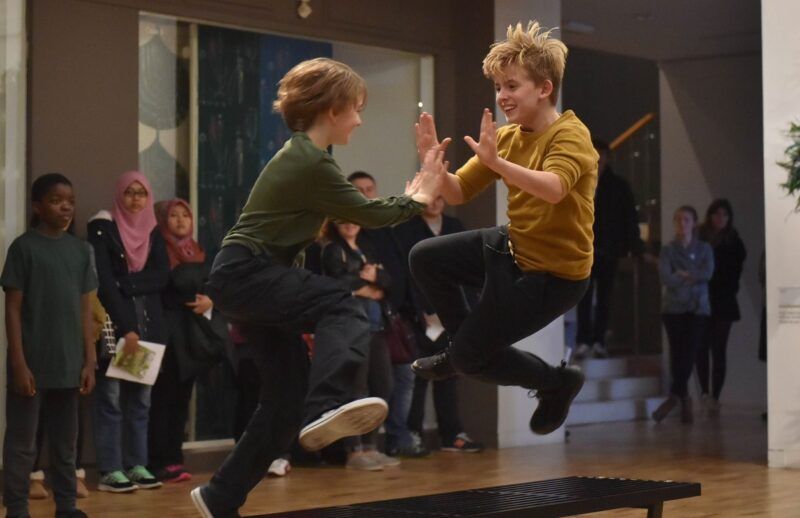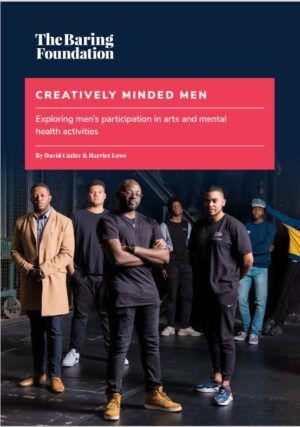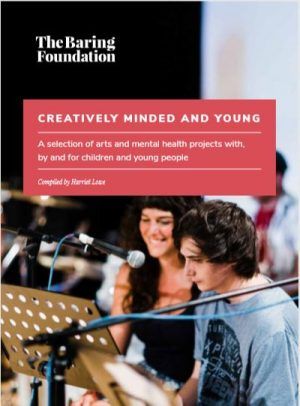As it turns out, boys are here, that is, high on the UK’s media’s agenda as I started to research this blog: in Adolescence, Netflix’s hard-to-forget drama released in March; in About the Boys, a very good BBC radio series that came out at the end of 2024 and features Dance United Yorkshire (see below); and in Sir Gareth Southgate’s Dimbleby Lecture.
But are boys engaging in creative mental health? We knew from our research and subsequent funding for men’s creative health (Creatively Minded and Men), that men are often (though not always) under-represented. So we wanted to extend the question down the age range to ask about boys aged 18 and under.
The answer is, as it often is, yes and no.
We spoke to five arts and mental health organisations about this issue: 42nd Street / The Horsfall, Company Chameleon, Gorsehill Studios, Dance United Yorkshire and MadLove.
Here are some of the things we learned.
Levels of engagement are usually lower for boys and reflect what we know about men’s engagement. For example, 42nd Street / The Horsfall said overall their referrals tend to be 30:70 boys/girls.
However, art form matters. Music and music production seems to attract boys more than other art forms. Gorsehill Studios in Manchester have a music studio and the balance there tends to be 60:40 boys to girls. Their dance activities are primarily attended by girls.
The situation is the same at 42nd Street: their dance group tends to be 100% female / non-binary but their music offers tend to be 50:50.
Very few boys were involved in 2.8 Million Minds, a youth arts advocacy project funded by Greater London Authority and the Baring Foundation and produced by MadLove.
In the most recent project Dance United Yorkshire undertook with referrals from CAMHS (Child and Adolescent Mental Health Services), only two out of 12 young people were boys.
Why might that be?
Kevin Edward Turner, dancer, producer and Director of Company Chameleon in Manchester, reflected that:
In my opinion it is always more challenging to get young men interested in creative health than young women, especially when you are asking them to engage with their own experiences. They do tend to find it more challenging to express their true thoughts and feelings and to be vulnerable. It is a process that you have to take them on to get to the place when they are able to engage deeply with the offer.
Rod Kippen, Clinical Lead for Creativity and Youth Social Action at The Horsfall, notes that a photography walk they ran was well attended by boys, and boys often prefer to learn technical artistic skills, whether photography or music production.
Ways to increase engagement
What about single-gender spaces? Interestingly, we failed to find any examples of boys-only creative mental health groups. This could be a failure of research, but it is in contrast to creative offers for adult men (18+) where many men-only spaces exist, not least the 1,100 Men’s Sheds in the UK, and many of the projects we are currently funding through our Creatively Minded Men round of funding.
The Horsfall prefers an inclusive approach for under-18s; this may be the same for other organisations in this space. The Horsfall do, however, have a creative group called Jet42 which is for young Black men aged 16+ and The Holburne Museum in Bath currently has a visual arts project for boys/young men aged 16-25, which is definitely unusual.
Our group shared their learning and made some suggestions:
Taking it slowly. Company Chameleon often say they are doing movement and theatre with the participants, so they do not get hung up on dance. They say that “athleticism is a good way to engage them first and then guide and shape the space to explore ideas and, more importantly, their own ideas.”

The Foundation is funding Contact theatre in Manchester to work with young men on a project that starts with music, which is more familiar, and develops into theatre-making, which is less.
More initial outreach. The Horsfall finds that boys need a bit of extra encouragement to get through the door. However, this kind of outreach can be labour-intensive and expensive. As an example, Dance United pick up their boys from home for their current dance project for Bradford City of Culture 2025.
Partnerships. Do arts organisations need to partner more outside their sector and meet boys where they already are? Many football clubs are engaging boys in conversations about mental health, for example. Company Chameleon’s Movement for Mind programme is taking dance for mental health into schools across Greater Manchester.

Familiar faces. Do we need more male artists and male artists of colour in the creative mental health field? It is a sector predominantly staffed and led by women (for a lot of reasons and this is not inherently a bad thing!). However, seeing yourself reflected in a lead artist and having an artist as role model could be more important in this demographic than some others. But this is not an easy fix.
Does it matter?
Our respondents agreed that it does.
Kevin from Company Chameleon says the following. It’s about dance but you could extend it widely across the participatory arts.
From the physicality we develop our power, strength, posture, alignment. And then also as it is an art form, we get to express our deepest experiences and use our creativity to devise new ways of expressing ideas and feelings. We develop our communication skills, collaboration skills and the confidence to share them in front of our crowd. Some of these things you get from sport, but in sport you do not get to explore and express your inner world, which does wonders for understanding yourself, your needs and ultimately your mental health.
With many thanks to: Rod Kippen (42nd Street/The Horsfall); Kevin Turner (Company Chameleon); Helen Linsell (Dance United Yorkshire); Caroline Gleaves (Gorsehill Studios); and James Leadbitter (MadLove) for their time and insights.

